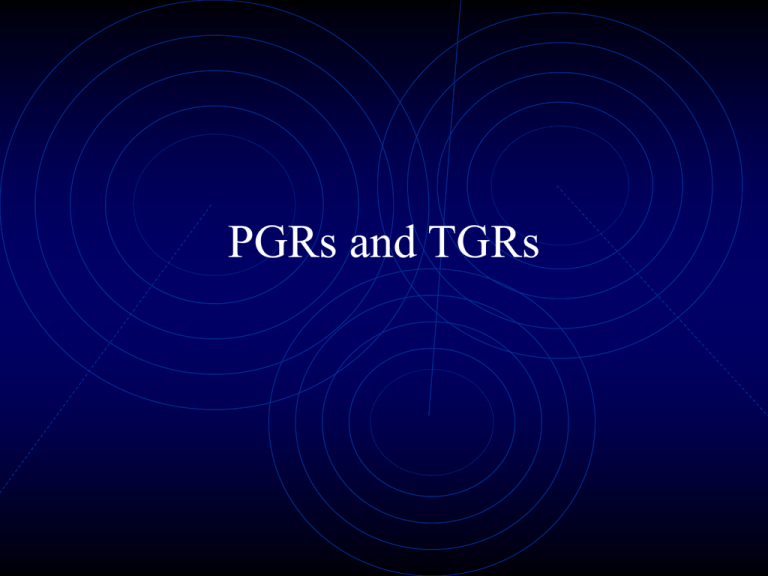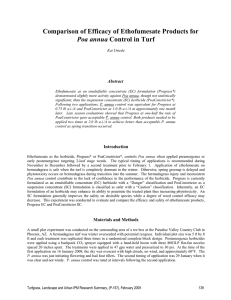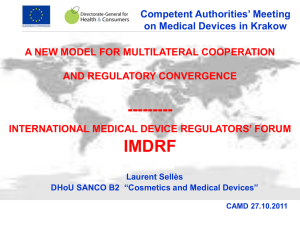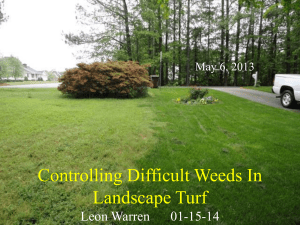PGRs and TGRs - Pesticide Truths
advertisement

PGRs and TGRs Different Modes of ActionType I and Type II • Type I growth regulators inhibit cell division. • Type I growth regulators are foliar absorbed. Different Modes of ActionType I and Type II • Most Type I Growth regulators are older materials that cause some phytotoxicity on grass. • Mefluidide (Embark) is utilized more than any other type I growth regulator, but it yellows and thins turf when used during hot weather conditions. Different Modes of ActionType I and Type II • Maleic hydrazide (MH-30, Royal Slo-Gro) is one of the oldest growth regulators used on turf, and causes extensive yellowing. Type I- Growth Regulators • Embark (mefluidide) is also used to inhibit seed head formation of Poa annua to improve the appearance and playability of fairways. • The rate used for seed head suppression is 1/12-1/16 of the growth regulation rate. Type I- Growth Regulators • Timing is critical- must be within two weeks of flowering to be effective. • Usually about two weeks after the first mowing is a good time to apply. • Some yellowing may still occur, but this can be reduced by using products like Ferremec.2 • If you are going to try it, read the label thoroughly! Type II Growth Regulators • Type II growth regulators work by inhibiting biosynthesis of gibberellin. • Since, gibberellin causes cell elongation, little or no elongation of cells occurs when GA is inhibited. Type II Growth Regulators • Type II growth regulators include: • • • • Cutless (Flurprimidol), Limit (amidochlor), Primo (trinexapac- ethyl) TGR Turf Enhancer (paclobutrazol) • http://www.uhsonline.com/prodframe.p hp Type II Growth Regulators • Type II growth regulators generally are less phytotoxic, and some actually have benefits other than reduced growth. • Amidochlor (Limit) is less damaging to turf than type I growth regulators, but still should not be used on high maintenance turf. Type II Growth Regulators • Many superintendents have tried Type II growth regulators as a means of reducing Poa annua on their golf courses. • http://www.andersonsgolfproducts.com/st_p oaannua.asp Type II Growth Regulators • Growth in Poa annua is reduced more than in Agrostis palustris, giving the creeping bentgrass a chance to spread into the territory held by Poa annua . (1,2,3,4,5) • Cutless, TGR Turf Enhancer and Primo have all been used in this way with varying degrees of success. (1,2,3,4) • Cutless and TGR Turf Enhancer are most effective in suppressing Poa annua but they also cause yellowing which may be unacceptable. Type II Growth Regulators • Other possible benefits of type II Growth Regulators include: • Reduced mowing- the duration of suppressed growth varies considerably (usually 4-7 weeks) depending on species, environmental and growth factors. (1,2,3,4) Type II Growth Regulators • Increased shoot density- more tillering (1,2,3,4) • Reduced water use- lower ET rates have been observed with Primo, Cutless and TGR. • However, Primo was the only material that enhanced turf quality during dry down in one study. (4) • Longer disease suppression with contact fungicides ?? Type II Growth Regulators • Flurprimidol and paclobutrazol have been shown to reduce dollar spot disease incidence somewhat on creeping bentgrass. • Improved green speed at mowing heights > 1/8” (research doesn’t back this theory up) Cutless Type II Growth Regulators • There are also some possible negative effects of Type I and II Growth Regulators. They include: • Reduced uniformity- regulation of growth can vary between grasses resulting in nonuniform appearance. Type II Growth Regulators • “rebound effect”- after the growth regulator wears off, there is often a flush of growth resulting in reduced turf quality and a need for increased mowing. • Primo and Embark have caused this response. • Increased weed problems- some weeds,like goosegrass, have less of a reduction in growth rate than turfgrasses. • Moreover, some weed species like crabgrass increase in shoot production due to increased tillering caused by some PGRs. (5) Type II Growth Regulators • Slower recuperation from injury? • Increased susceptibility to some diseases? Type I growth regulators have shown to cause increased disease problems.(2) New Classification Scheme for TGRs • A new way to classify growth regulators has been developed using classes A,B,C, and D. • Class A materials are GA inhibitors that interfere with GA synthesis late in the biosynthetic pathway. • Only Trinexapac-ethyl is in the category. New Classification Scheme for TGRs • Class B materials interfere with GA synthesis early in the biosynthetic pathway. • Fluprimidol and paclobutrozol are included in this class. • Class C materials inhibit mitosis. • Hyradazide, mefluidide and amidochlor are in this category. • Class D materials are phytotoxic (can kill plants) but have a growth regulating effect at very low rates. • Glyphosate (Roundup) and chlorsulfuron (Telar) are examples. A “New” Growth Regulator for Turf • Proxy (ethephon) recently received a label for turfgrass use. • Ethephon works by releasing ethylene into turfgrass leaves. (2) • Ethephon has a more subtle action than type I or type II inhibitors with no noticeable change in growth habit for about 2 weeks.(2) A “New” Growth Regulator for Turf • Ethephon does not fit into the A,B,C,D scheme of classification either. • Ethephon has no rebound effect like Primo and Embark do. A “New” Growth Regulator for Turf • Proxy may be very effective in battling Poa annua with growth reduction as high as 90% with an average of 38% over seven weeks • Bentgrass growth reduction with Proxy was a maximum of 50% and a 14% average over seven weeks. (2) A “New” Growth Regulator for Turf • Proxy is not labeled for greens- further testing needs to be done. • Proxy is also labeled for Poa annua seed head supression. • Nick Christians claims that Poa pratensis treated with Proxy changed in form to an almost stoloniferous growth habit, which might improve wear tolerance. Fertility and Growth Regulators • It is generally best to keep fertility levels somewhat higher on turf treated with growth regulators than on non- treated turf because: • Growth regulation effects seem to be enhanced at higher fertility levels. • Higher fertility levels help to mask the chlorosis that sometimes appears when growth regulators are used. Seedhead Management & Plant Growth Regulators • Poa is not a single, uniform turf species. • It has a large number of turf subspecies or biotypes. Seedhead Management & Plant Growth Regulators • Poa annua can range from: • annual types that die each spring following a period of intense seedhead formation. • Biotypes that live for several years and flower later in the season for longer periods of time. • It is impossible to predict which biotypes you have on your course. • The many biotypes is the #1 reason its so hard to predict precisely when the seed will form. Seedhead Management • At courses where Poa is tolerated, reducing seed heads makes a difference. • Most seed head management has relied on a combination of cultural practices and applications of PGR’s. • The cultural practices used to improve mowing when seed heads are present include brushing and vertical mowing. • Proxy is becoming the preferred chemical for seed head management. Seedhead Management & PGR’s • Mefluidide is well known for its ability to slow down or stop seedhead formation. • Mefluidide is used to inhibit Poa Seedhead formation on golf courses. • Under optimal conditions, applications can result in 85 – 90% Poa annua seedhead suppression. • There are some drawbacks of using this product. Drawbacks of Using Mefluidide • Varying Turf Response -Using PGR’s to slow seedhead formation came into use in the 90’s, but results vary greatly by location. -Seedhead suppression will last from 3 – 6 weeks. -To keep seedheads formation consistently low, you will need to increase the rate gradually after each application. -Success depends greatly on the skill of the superintendent to adapt the program to his or her course. Drawbacks of Using Mefluidide • Timing of the First Application -Because this product does not affect seedheads that already exist the first application needs to be made two weeks before the first flush of seedheads. -The first application will need to be at different times in different location or different climates. References • 1. Christians, Nick, Creative Uses for Turfgrass Growth Regulators, USGA Green Section Record, September-October 2001, p.11-13. • 2. Dernoeden, Peter. Creeping Bentgrass Management. Sleeping Bear Press, Inc. Chelsea, MI, 2000. • 3. Diesburg, Kenneth. A New Growth Regulator for Golf Course Turfgrass. Golf Course Management. November 1998. • 4. Fermanian, Tom. Managing Bentgrass Fairway Growth with PGRs. Grounds Maintenance. May 1997. References • 5. Fry, J.D. Plant Growth Regulators May Help Reduce Water Use. Golf Course Management. November 1998. • 6. Lowe, Todd et al. Some weeds Flourish Under Growth Regulators. Golf Course Management. September 1999. LINKS • http://www.grounds-mag.com/managing.htm • http://virtual.clemson.edu/groups/hort/sctop/TURF Sec/weedsci/weedsci5.htm • http://www.cp.us.novartis.com/products/specialty/ PrimoWSB.shtml • http://link.springerny.com/link/service/journals/10088/bibs/38n4p102 8.html • http://www.turf.uiuc.edu/itf/tips/tt97-2.html LINKS • http://www.hort.iastate.edu/pages/news/turfr pt/1999/greenpoa98.html • http://www.msu.edu/user/rogersj/laplata.ht ml • http://edis.ifas.ufl.edu/scripts/htmlgen.exe? DOCUMENT_WG064









